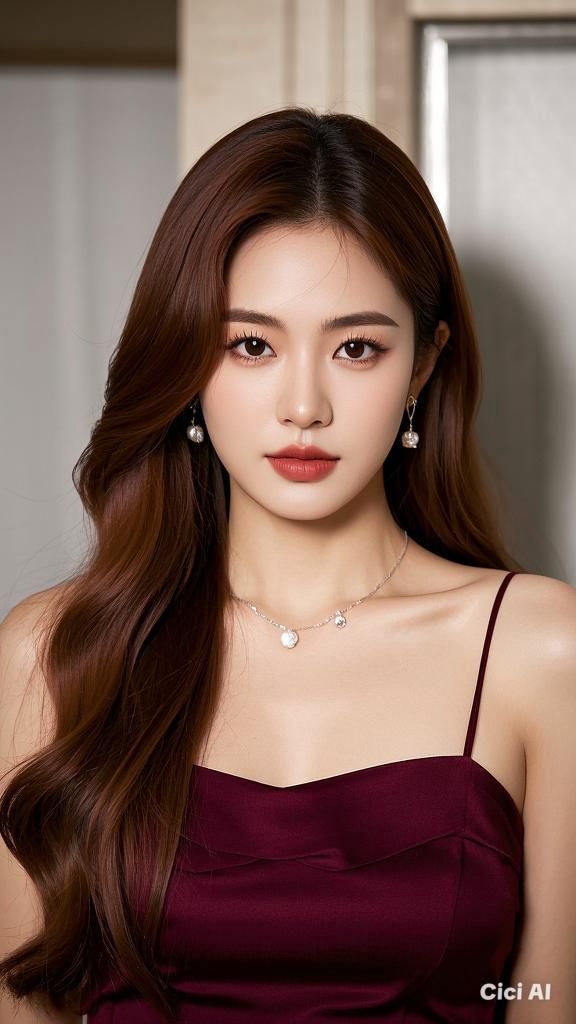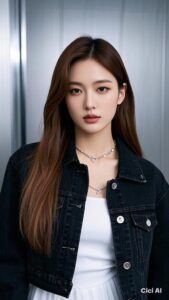Digital Art
Top Trending AI Beauties Inspired by Real-World Cultures: A Fusion of Technology and Culture

As Top Trending AI Beauties Inspired by Real-World Cultures takes center stage, this opening passage beckons readers into a world crafted with good knowledge, ensuring a reading experience that is both absorbing and distinctly original.
Explore the fascinating realm where technology meets tradition, as AI beauties inspired by real-world cultures come to life in a mesmerizing blend of innovation and heritage.
 AI beauties inspired by real-world cultures refer to artificial intelligence creations that draw influences from diverse cultural backgrounds, traditions, and aesthetics. These AI beauties are designed to embody the beauty standards, fashion trends, and unique characteristics of various cultures, offering a fusion of technology and cultural diversity in the digital realm.Integrating cultural elements into AI creations holds significant importance as it promotes inclusivity, celebrates diversity, and fosters cultural exchange in the virtual world.
By infusing AI beauties with elements from different cultures, creators can showcase the richness and beauty of global heritage, challenging stereotypes, and promoting cross-cultural understanding.
AI beauties inspired by real-world cultures refer to artificial intelligence creations that draw influences from diverse cultural backgrounds, traditions, and aesthetics. These AI beauties are designed to embody the beauty standards, fashion trends, and unique characteristics of various cultures, offering a fusion of technology and cultural diversity in the digital realm.Integrating cultural elements into AI creations holds significant importance as it promotes inclusivity, celebrates diversity, and fosters cultural exchange in the virtual world.
By infusing AI beauties with elements from different cultures, creators can showcase the richness and beauty of global heritage, challenging stereotypes, and promoting cross-cultural understanding.

Introduction to AI Beauties Inspired by Real-World Cultures
 AI beauties inspired by real-world cultures refer to artificial intelligence creations that draw influences from diverse cultural backgrounds, traditions, and aesthetics. These AI beauties are designed to embody the beauty standards, fashion trends, and unique characteristics of various cultures, offering a fusion of technology and cultural diversity in the digital realm.Integrating cultural elements into AI creations holds significant importance as it promotes inclusivity, celebrates diversity, and fosters cultural exchange in the virtual world.
By infusing AI beauties with elements from different cultures, creators can showcase the richness and beauty of global heritage, challenging stereotypes, and promoting cross-cultural understanding.
AI beauties inspired by real-world cultures refer to artificial intelligence creations that draw influences from diverse cultural backgrounds, traditions, and aesthetics. These AI beauties are designed to embody the beauty standards, fashion trends, and unique characteristics of various cultures, offering a fusion of technology and cultural diversity in the digital realm.Integrating cultural elements into AI creations holds significant importance as it promotes inclusivity, celebrates diversity, and fosters cultural exchange in the virtual world.
By infusing AI beauties with elements from different cultures, creators can showcase the richness and beauty of global heritage, challenging stereotypes, and promoting cross-cultural understanding.
Examples of Popular AI Beauties Influenced by Diverse Cultures
- Virtual influencers like Lil Miquela, who blends elements of different cultures in her fashion choices and digital persona, appealing to a wide audience globally.
- Avatar characters from popular video games and animated films, such as those in "Avatar: The Last Airbender," that draw inspiration from various real-world cultures to create unique and visually stunning characters.
- Virtual fashion models like Shudu Gram and Noonoouri, who showcase traditional and contemporary fashion styles from around the world, reflecting the beauty and diversity of global fashion.
Real-World Cultural Influences on AI Beauties
When it comes to creating AI beauties inspired by real-world cultures, designers draw from a rich tapestry of traditions, beliefs, and aesthetics. These cultural influences are not only reflected in the physical appearance of AI beauties but also in their personalities, behaviors, and values.Japanese Influence
Japanese culture has been a significant source of inspiration for AI beauties, with their emphasis on elegance, simplicity, and harmony. AI designs often incorporate elements such as traditional kimono patterns, cherry blossoms, and geisha-inspired hairstyles. The graceful and respectful demeanor of Japanese AI beauties reflects the cultural values of politeness and humility.African Influence
The vibrant and diverse cultures of Africa have also left a mark on AI beauty designs. From bold and colorful tribal patterns to intricate beadwork and braided hairstyles, African-inspired AI beauties celebrate the continent's rich heritage. These AI characters often exude strength, resilience, and a deep connection to nature, reflecting the cultural values of community and spirituality.Indian Influence
Indian culture, with its vibrant colors, intricate designs, and spiritual symbolism, has inspired AI beauties that are a feast for the senses. From elaborate henna patterns to opulent silk sarees and sparkling jewelry, Indian-inspired AI characters embody beauty, grace, and tradition. These AI beauties often exhibit warmth, hospitality, and a strong sense of family ties, reflecting the cultural values of unity and respect.Latin American Influence
The rich tapestry of Latin American cultures, with their passion, rhythm, and diversity, has influenced AI beauty designs that are full of life and energy. From flamenco-inspired dresses to colorful sugar skull makeup and flowing salsa dance moves, Latin American-inspired AI characters capture the spirit of fiesta and celebration. These AI beauties radiate warmth, joy, and a zest for life, reflecting the cultural values of connection, joy, and resilience.Technology and Artistry in Creating AI Beauties
Artificial Intelligence (AI) plays a crucial role in creating beauties inspired by real-world cultures. The technology behind these AI beauties involves sophisticated algorithms and machine learning processes that analyze different cultural aesthetics and features to generate realistic representations.Technology Used in Creating AI Beauties
- Generative Adversarial Networks (GANs): GANs are commonly used in creating AI beauties by generating new images based on existing cultural references. These networks consist of two neural networks - a generator and a discriminator - that work together to produce authentic-looking images.
- Style Transfer: Style transfer techniques enable AI to mimic the artistic style of a particular culture when generating images. By transferring the style of famous artworks or photographs, AI can create beauties that reflect the unique visual characteristics of different cultures.
- Facial Recognition Technology: Advanced facial recognition technology is employed to ensure that AI beauties accurately capture the facial features and expressions characteristic of a specific culture. This technology helps in creating culturally authentic representations.
Artistic Elements in Designing Culturally Inspired AI Beauties

- Color Palette: The selection of colors in AI beauties is crucial in capturing the essence of a particular culture. Artists and designers often choose color schemes that are traditionally associated with a specific culture to evoke a sense of cultural identity.
- Symbolism: Incorporating symbolic elements from different cultures adds depth and meaning to AI beauties. Symbols such as flowers, animals, or patterns can convey cultural messages and values in the design of these beauties.
- Hairstyles and Accessories: Paying attention to hairstyles, accessories, and traditional attire is essential in creating culturally inspired AI beauties. These elements help in portraying the unique fashion and beauty standards of different cultures.
Comparison with Traditional Art Forms
- Traditional art forms often rely on manual techniques and craftsmanship to create culturally significant artworks, whereas AI-generated representations focus on algorithmic processes and data analysis to capture cultural aesthetics.
- AI beauties may lack the emotional depth and human touch present in traditional art forms, but they excel in precision and accuracy when replicating cultural beauty standards and features.
- While traditional art forms celebrate the individuality and creativity of artists, AI beauties showcase a fusion of technology and artistry in producing diverse representations of cultural beauty.
Ethical Considerations in Developing AI Beauties
When creating AI beauties inspired by real-world cultures, it is crucial to consider the ethical implications of this process. Cultural appropriation, misrepresentation, and stereotyping are some of the key concerns that need to be addressed to ensure respectful and responsible representation of diverse cultures.Cultural Appropriation in AI Design
Cultural appropriation in AI design occurs when elements of a particular culture are used without permission or understanding of their significance. This can lead to the distortion or oversimplification of cultural symbols, beliefs, or practices, reinforcing stereotypes and disrespecting the original culture. It is essential to conduct thorough research and consultation with cultural experts to avoid appropriating elements in AI beauties that may be sacred or culturally sensitive.Implications of Misrepresentation
Misrepresentation in AI beauties can perpetuate harmful stereotypes and biases, impacting how individuals from that culture are perceived and treated. It is crucial to ensure that AI beauties accurately reflect the diversity and complexity of cultures, avoiding homogenization or exoticization. By incorporating a diverse range of cultural influences with sensitivity and authenticity, AI beauties can celebrate the richness of global heritage without perpetuating harmful narratives.Strategies for Responsible Representation
To ensure respectful and responsible representation of cultures in AI beauties, developers should collaborate with diverse cultural communities, artists, and scholars throughout the design process. By prioritizing inclusivity, authenticity, and cultural sensitivity, developers can create AI beauties that celebrate cultural diversity while avoiding stereotypes and misappropriation. Additionally, incorporating principles of informed consent, transparency, and accountability into AI design practices can help mitigate ethical concerns and promote ethical standards in the development of AI beauties.Closing Notes
In conclusion, the captivating journey through the realm of AI beauties inspired by real-world cultures unveils a tapestry of creativity and diversity, offering a glimpse into the harmonious fusion of technology and tradition.Clarifying Questions
How are real-world cultures incorporated into AI beauties? The cultural influences are integrated through design elements, aesthetics, and traditional motifs that reflect the essence of diverse cultures. What is the significance of cultural diversity in AI beauty perception? Cultural diversity enhances the richness and authenticity of AI beauties, offering a broader representation of beauty standards worldwide. How can ethical concerns in AI beauty development be addressed? By prioritizing cultural sensitivity, respecting intellectual property, and collaborating with cultural experts, ethical considerations can be effectively managed.
-

 General8 months ago
General8 months agoBest Insurance Lawyers Near Me for Claim Disputes: Your Ultimate Guide to Legal Assistance
-

 General8 months ago
General8 months agoNavigating Insurance Claim Denial Lawyers Near Me
-

 Design8 months ago
Design8 months agoOutdoor Design Essentials for a Holistic Lifestyle: Integrating CRM Automation for Lifestyle eCommerce Brands
-

 General8 months ago
General8 months agoWellness Lifestyle and Outdoor Living Integration Tips: Modern Farmhouse Exterior Ideas for Luxury Lifestyle Homes
-

 General8 months ago
General8 months agoThe Best Business Insurance for Interior Designers: A Comprehensive Guide
-

 General8 months ago
General8 months agoCrafting a Comprehensive Guide to Medical Malpractice and Insurance Settlement Law Firms
-

 General8 months ago
General8 months agoHow Exterior Renovations Affect Your Home Insurance Rates: A Comprehensive Guide
-

 General7 months ago
General7 months agoDigital health trends transforming Asia in 2025: A Glimpse into the Future of Healthcare




